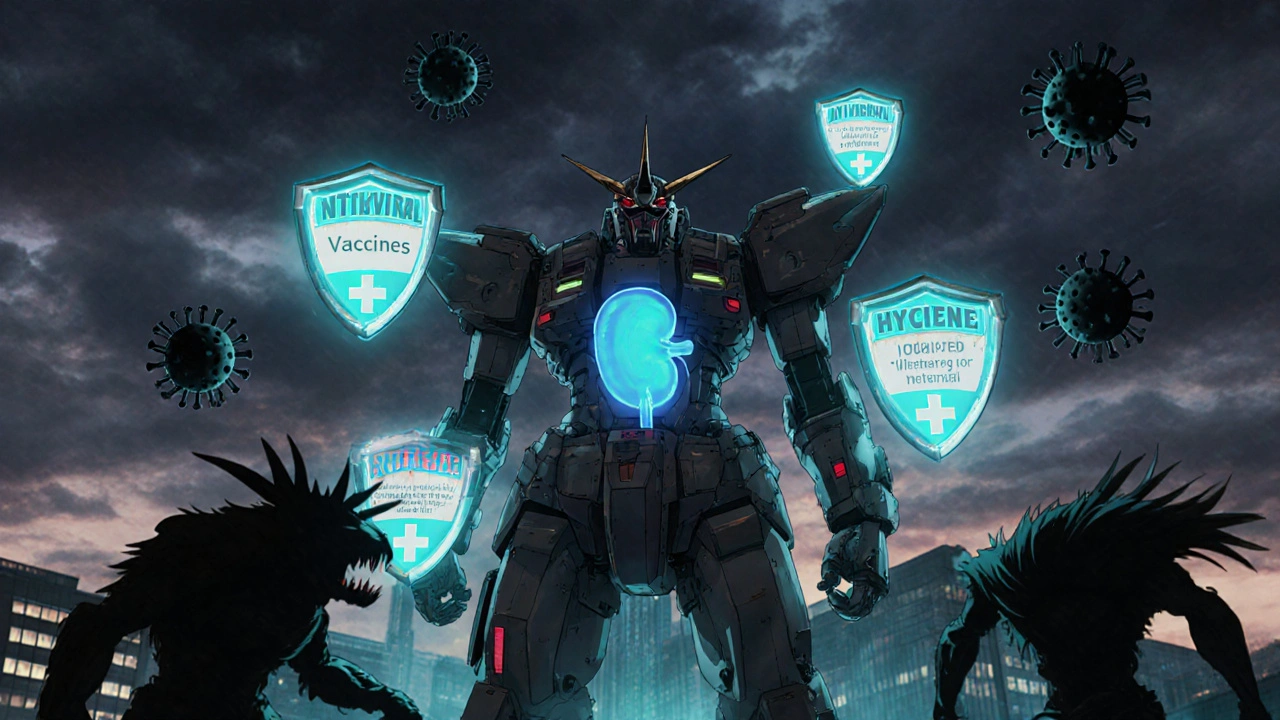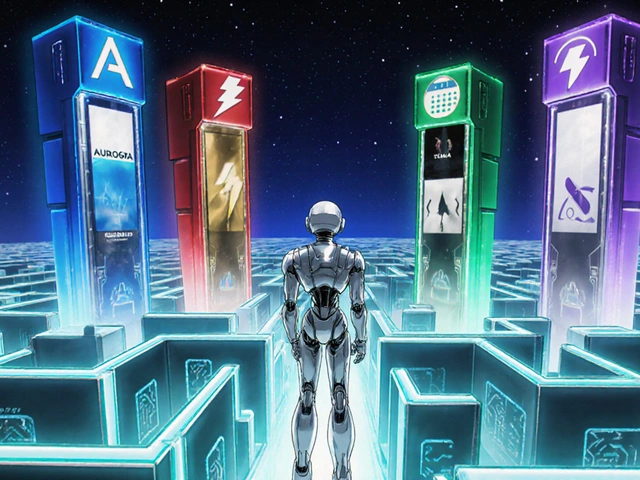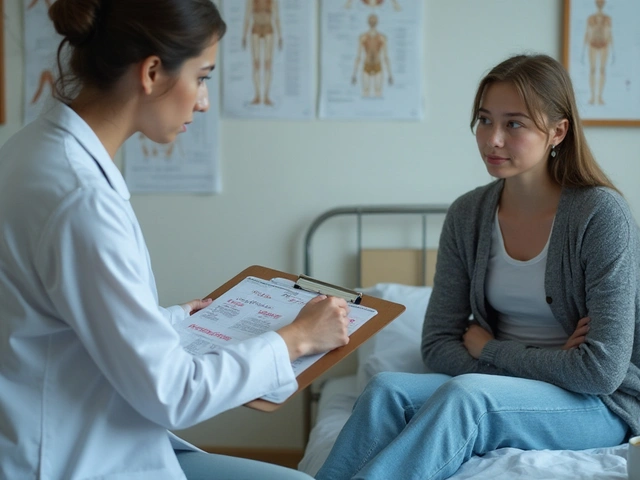Why Infections Are the Biggest Threat After a Kidney Transplant
After a kidney transplant, your new organ is safe - but your body is under siege. The very drugs that keep your immune system from rejecting the kidney also leave you wide open to infections. Bacteria, viruses, fungi - they all see you as an easy target. In fact, post-transplant infections are the leading cause of death in the first year after surgery, even more than rejection in many cases.
It’s not just about getting sick. A single infection can trigger rejection, damage your new kidney, or send you back to the hospital for weeks. The good news? Most of these infections are preventable. It’s not magic. It’s a clear, step-by-step plan built on medicine, vaccines, and everyday choices.
Three Pillars of Infection Prevention
There are only three ways to stop infections after a transplant: medicines you take, shots you get, and habits you change. Get all three right, and your risk drops dramatically.
1. Preventive Medicines: The First Line of Defense
Right after your transplant, you’ll be on a cocktail of anti-infective drugs. These aren’t optional. They’re life-saving.
- For herpes viruses (HSV, VZV): Acyclovir or valacyclovir for 1 to 3 months. These prevent cold sores and shingles, which can spread fast when your immunity is low.
- For CMV (cytomegalovirus): If you’re a high-risk patient (donor positive, recipient negative), you’ll take valganciclovir for 3 to 6 months. CMV doesn’t just cause fever and fatigue - it increases your chance of rejection by up to 34% and can destroy your new kidney.
- For Pneumocystis pneumonia (PCP): Trimethoprim-sulfamethoxazole (Bactrim) is given for at least 6 months. This fungus lives in the air but only makes you sick when your defenses are down.
- For fungal infections: Fluconazole or posaconazole may be used if you’re at high risk, especially after a stem cell transplant.
These drugs are timed precisely. Stop too early? You’re at risk. Stay on too long? You risk side effects like kidney damage or drug-resistant infections. Your team will adjust based on your blood tests and how your body responds.
2. Vaccines: Timing Is Everything
You can’t get most vaccines after a transplant - your immune system won’t respond. So the best time is before surgery.
- Before transplant: Get all routine shots - flu, pneumonia, hepatitis B, tetanus, and COVID-19. Live vaccines like MMR, varicella, and nasal flu spray are dangerous after transplant. Get them at least 4 weeks before surgery.
- After transplant: Wait at least 6 months. Then, you can get inactivated vaccines: flu shot (injectable only), pneumonia (PCV20 or PPSV23), tetanus, and COVID boosters. These are safe and effective.
- Your family matters too: Everyone living with you should be up to date on flu, whooping cough, and COVID vaccines. This is called "cocooning" - it creates a shield around you.
Don’t assume you’re protected because you got a shot years ago. Immunity fades. Your doctor will check your antibody levels and recommend boosters if needed.
3. Lifestyle Changes: Your Daily Protection
Medicines and vaccines protect you inside. Your habits protect you outside.
- Food safety: No raw fish, undercooked meat, or unpasteurized cheese. Listeria in deli meats or soft cheeses can cause deadly infections. Wash all fruits and vegetables. Use separate cutting boards for meat and veggies.
- Water and soil: Avoid garden soil, compost piles, and dusty construction areas. Fungi like histoplasmosis live in bird or bat droppings. If you live in Ohio, the Midwest, or the Mississippi River Valley, this is a real risk. Wear an N95 mask if you must be around dirt.
- Hand hygiene: Wash hands with soap and water for 20 seconds - longer than singing "Happy Birthday" twice. Use alcohol-based sanitizer when soap isn’t available.
- People: Avoid crowds during flu season. Skip visits from anyone with a cold, cough, or fever. Wear a mask in hospitals, clinics, and public transit.
- Pets: Cats and dogs are fine - but no new pets right after transplant. Don’t clean litter boxes or bird cages. Wash hands after petting. Avoid reptiles and exotic animals - they carry salmonella and other bugs.
Monitoring: Catching Infections Before They Spread
You won’t always feel sick. That’s the danger. Infections can creep in silently.
That’s why monitoring isn’t optional - it’s part of your routine.
- CMV tracking: Blood tests every 1 to 2 weeks for the first 3 months, then monthly for 6 months. PCR tests detect CMV DNA before you have symptoms. If it shows up, treatment starts immediately - no waiting.
- Fungal detection: Blood tests for beta-D-glucan and galactomannan can catch aspergillosis early. This is critical if you’ve had a stem cell transplant or are on high-dose steroids.
- Drug-resistant bugs: If you’ve been hospitalized before or had multiple antibiotics, your team may do weekly stool or nasal swabs to check for MRSA or ESBL bacteria. These are hard to treat and can turn into bloodstream infections.
- Central line care: If you have a port or PICC line, staff will clean the site daily with chlorhexidine. You’ll learn how to check for redness, swelling, or pus. Any sign? Call your team immediately.
Don’t ignore tiny symptoms. A low-grade fever, mild diarrhea, or a cough that won’t quit could be the first sign of something serious. Your transplant team needs to hear from you - even if you think it’s "nothing."

What’s New in 2025: The Next Wave of Protection
Science is moving fast. Here’s what’s changing:
- Letermovir: A new drug approved for CMV prevention in high-risk patients. It’s safer than valganciclovir and can be used beyond 100 days - a game-changer for patients who still face risk after stopping older drugs.
- Fecal microbiota transplant (FMT): Still experimental, but promising. FMT restores healthy gut bacteria to fight off drug-resistant bugs like C. diff and ESBL-producing E. coli. Early trials show it can reduce colonization by 70%.
- CMV vaccines: No vaccine is approved yet, but 5 are in late-stage trials. One candidate reduced infection rates by 50% in early studies. If approved, it could eliminate the need for lifelong antivirals.
- Personalized immunosuppression: New blood tests now measure your immune response in real time. Doctors can lower your anti-rejection drugs if your infection risk is high - without risking rejection.
What Happens After 6 Months?
Many patients think they’re "out of the woods" after six months. They’re wrong.
Yes, the strongest anti-infective drugs are stopped. But your immune system is still recovering. You’re still at higher risk than healthy people.
Community infections - flu, RSV, COVID, even common colds - become the biggest threat. That’s why:
- You still need annual flu shots
- You still wear a mask in hospitals and during outbreaks
- You still avoid raw foods and risky environments
- You still report every fever, no matter how small
Long-term, your infection risk slowly declines - but never disappears. Think of it like wearing a seatbelt. You don’t stop because you’ve driven 100 miles. You keep doing it because the risk is always there.

When to Call Your Transplant Team
Don’t wait. Don’t hope it goes away. Call immediately if you have:
- Fever over 100.4°F (38°C), even once
- Diarrhea lasting more than 24 hours
- New cough, shortness of breath, or chest pain
- Red, swollen, or draining area around your incision or catheter
- Unexplained fatigue, confusion, or dizziness
- Any new rash or skin sore
These aren’t "maybe" signs. They’re red flags. Every hour counts.
Can I get the shingles vaccine after a kidney transplant?
No - the live shingles vaccine (Zostavax) is not safe after transplant. But the non-live recombinant shingles vaccine (Shingrix) is recommended and safe. Get it 6 months after transplant, even if you’ve had shingles before. Two doses are needed, 2 to 6 months apart.
Is it safe to travel after a kidney transplant?
Yes - but only after 6 months and with planning. Avoid areas with poor sanitation, malaria, or outbreaks. Get travel-specific vaccines before transplant if possible. Carry your transplant card, medication list, and your doctor’s contact info. Avoid raw food, tap water, and street vendors. Always wear a mask on planes.
Why can’t I take antibiotics for every cold after transplant?
Most colds are caused by viruses - antibiotics don’t work. Taking them unnecessarily kills your good gut bacteria and lets drug-resistant bugs grow. If you’re sick, your transplant team will test you first. Only use antibiotics if they confirm a bacterial infection.
Do I need to avoid pets forever?
No. You can keep pets you already have - but don’t get new ones in the first year. Don’t clean litter boxes, bird cages, or fish tanks. Wash your hands after petting. Avoid reptiles, amphibians, and exotic animals. Pets provide emotional support - just manage the risks.
What’s the biggest mistake transplant patients make?
Waiting too long to report symptoms. Many patients think, "I’ll wait and see." But infections after transplant don’t wait. A fever of 100.4°F is an emergency. Delaying care increases your risk of sepsis, organ damage, and death. Call your team at the first sign.
Next Steps: What You Should Do Today
Don’t wait for your next appointment. Take action now:
- Check your vaccine records. Are you up to date on flu, pneumonia, and COVID? If not, schedule shots - but only after talking to your transplant team.
- Review your meds. Are you still on your antiviral or antifungal? Don’t stop without asking.
- Start a symptom journal. Write down any fever, cough, or change in energy. Bring it to every visit.
- Teach someone in your household how to recognize infection signs. You might not feel well enough to speak up.
- Remove risky foods from your pantry: raw oysters, blue cheese, undercooked eggs, unpasteurized juice.
Your new kidney is a gift. But staying healthy is your job. Do it right - and you’ll have years, not months, to enjoy it.





![Insightful Review on the Latest Developments in [Topic Area]](/uploads/2024/07/thumbnail-insightful-review-on-the-latest-developments-in-topic-area.webp)
Post A Comment